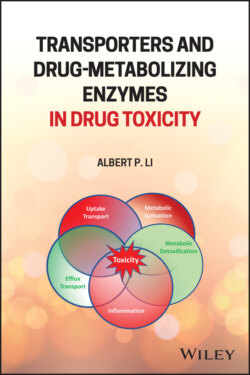Читать книгу Transporters and Drug-Metabolizing Enzymes in Drug Toxicity - Albert P. Li - Страница 26
2.3.1 Metabolism and Reactive Metabolites
ОглавлениеMany enzymes can generate and release RMs. Particularly, cytochromes P450, together with the reactivity of their oxygen intermediates, are the main drivers in catalyzing the formation of relatively inactive substrates into diverse chemically reactive species. These P450 enzymes are present in the ER and their hepatic expression is concentrated in the liver’s centrilobular region; this is consistent with the typical histological findings of centrilobular necrosis in many acute DILI cases. Many drugs can form RMs, which are catalyzed by P450 enzymes and cause hepatotoxicity [10]. For example, acetaminophen is primarily metabolized via glucuronidation and sulfonation pathways, and the regular metabolites are rapidly excreted in urine. However, a small proportion of acetaminophen is metabolized by CYP3A4, CYP2E1, and CYP1A2, and undergoes bioactivation to form the RM, N‐acetyl‐p‐benzoquinoneimine (NAPQI). At therapeutic doses, NAPQI can be rapidly detoxified by conjugation to GSH and safely eliminated from the liver. Acetaminophen overdosing, on the other hand, can result in GSH depletion and NAPQI accumulation, eventually leading to oxidative stress reactions, dysfunction of mitochondria, and DNA damage.
Phase II enzymes undoubtedly play an important role in the detoxification of various xenobiotics, but some, including UGTs, GSTs, NATs, and SULTs, also could catalyze the formation of RMs. Hepatotoxicity is considered a class effect of nonsteroidal anti‐inflammatory drugs (NSAIDs) and the carboxylic acid functional groups they contain can undergo bioactivation to form acyl glucuronides by hepatic UGT isoforms. Benoxaprofen was an NSAID withdrawn from market in 1982 following several reports of fatal cholestatic jaundice. It contained a carboxylic acid moiety that can form a reactive acyl glucuronide and results in covalent protein adducts as reported from in vitro incubations with rat liver microsomes and from in vivo studies [11]. In FDA’s guidance for industry on safety testing drug metabolites [12], additional safety assessments are required for products that potentially could form reactive acylglucuronides.
